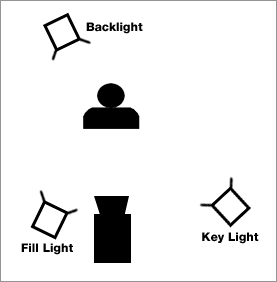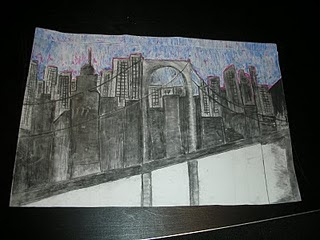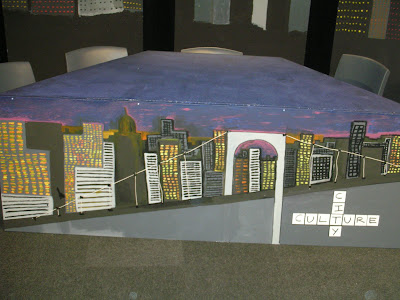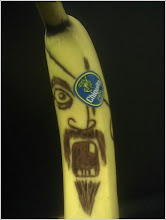week one:
During the first week of our multi-camera project, we were divided into small groupsof four. It was from these groups that we were each assigned a role to perform in the show. i choose to be the Art Director. As an Art director it was my job to draw out ideas for a set design. This included ideas for colours, logos and layout of the set. After the class decided a theme for the quiz show, each group was given a round to work on. As the theme of our quiz show was Media, our group was given the television round to focus on.
Week two
The second week was more productive than the first. During then second week me and the other Art Directors got together and voiced our ideas and opinions on each others ideas for a set. Eventually we all decided that we were going to somehow created a city-scape. We thought that this was a good effective idea for a set design as it tied in with the idea of a Media theme because a city is full of advertising and culture. We also drew up a rough design of what we could put on the set.
Week three
During the third week, i mostly just painted the set. I painted the sky on all of the flats, drew the buildings, and painted the city scape onto the boards. Later that week I painted the lights in the building for the set to make it seem more realistic as a cityscape in Silhouette. i also set of to create a logo for the project, and i came up with the idea of having the name of the show in an over lapping crossword grid. It was then decided that the show would be named Culture City.
Week four
This week we finished off the flats and began rehearsals using the last groups script. We each rotated through different roles within the studio, this was really fun as it gave us the chance to have a go at lots of the different roles. I was on camera through most of the reheasals, but i also found my self vision mixing and playing the role of a contestant. i enjoyed being a camera man the most and i decided that it was what i wanted to in the live shoot.
Week five
This week we spent everyday doing rehearsals, I got to have a go on sound and perfecting camera operation. Both roles I enjoyed and found no difficulty performing, but I decided that i preffered to operate the camera. i enjoyed being a cameraman because it gave me the hands on experience that i want to gain from my time on the course. during the reheasals i found my self gaining in confidence with my camera work and with my self in general. i feel that being part of a large team boosted my confidence with the group. i am very happy with the turn out of our quiz show. i think that everyone performed there roles with very little error and that our final product was very much worth the effort that everybody put into it. i am very pleased with the work i did on the set design, i dont think we could have done anything else that would have worked quite as good as our design did. i also thought that stuart did a very good job as director, I also asked Stuart if I could use some of his pictures on my blog because he had taken pictures of our set. i have enjoyed this project very much.
Wednesday, 10 February 2010
Reheasals, Recording practise and Technical reheasals
Before we recorded the show live, we did plenty of reheasals. for these rehearsals we each performed the roles we had requested as well as taking turns to be guests and then ran through the show. Doing the reheasals i took role as a camera man, i cycled through each camera and mastered the shots i had to deliver. It was important to do these rehearsals to work out if there were any techincal problems or anything wrong with our questions. From doing reheasals we found that some of the questions were to easy, so we set off to make them more challenging. We also had to decide whether it was going to be possible to have buzzers in our quiz show. Recording practice allowed us to work effectively together as a group. It definately gave us more confidence knowing that our show would work. Although, at first it did not seem that way.
From technical rehearsals we learned that our buzzers sounded too similar, so we had to find an alternative for one of the buzzers. we were originally using two dog toy squeekers as our buzzers. so we replaced one of the toys with a bell. Another problem we had to deal with was that the VTs were not in the correct order on the DVD, as a consequence this meant that we had to edit our script and our running order. Despite this we also found benefit from technical reheasals as they helped us improve our skills as camera crew by constantly reframing and changing from camera shots. It also helped us adjust the sound levels so that they were just right and let us practise on when to cut from the VT inserts back to the studio. Without the reheasals we did, our show definately would not have turned out as successful as it did in the LIVE shoot.
From technical rehearsals we learned that our buzzers sounded too similar, so we had to find an alternative for one of the buzzers. we were originally using two dog toy squeekers as our buzzers. so we replaced one of the toys with a bell. Another problem we had to deal with was that the VTs were not in the correct order on the DVD, as a consequence this meant that we had to edit our script and our running order. Despite this we also found benefit from technical reheasals as they helped us improve our skills as camera crew by constantly reframing and changing from camera shots. It also helped us adjust the sound levels so that they were just right and let us practise on when to cut from the VT inserts back to the studio. Without the reheasals we did, our show definately would not have turned out as successful as it did in the LIVE shoot.
Scripting
The script is most important thing for a quiz show to be succesful as it contains all the technical information that the director and DVD operators need to follow, as well as the dialogue of the host, the audio insert lengths for the Sound, DVD operators and for the assistant director to keep track off on behalf of the director. The script also mentions and gives advice on which camera shots should be used for opening of the show, as well as listing all the AD LIB shots the director is looking for in the rest of the show. the layout of a TV script is so that all sound used regardless of if its coming from the host, theguests or from VT inserts always goes on the right hand side of the script. And all vision information goes on the left side of the script. this is done becuase it makes the script much easier to follow for director, assistant director, floor manager and DVD operator. Whenever the director calls the number of the camera he wishes to cut to it means that the vision mixer should cut to that camera as listed in the script. If its a VT insert then the director calls to roll VT insert when it should be called, and where it is writen in the script.
This is a photograph of our Quiz show script.

This is a photograph of our Quiz show script.

Lighting the set
When it came to lighting the set we placed the backboards and the rest of the set in the studio and sat five people around the table to represent our four guests and host. We found that the best way to light the set and our host/guests was to use Three point lighting. Three point lighting is when there is a key light that is usually a powerful spot light (tungsten light) aimed at your subject, this creates a shadow down one side. To counter this, we used a fill light (cool light) and pointed it at the other side of the subject. After we lit the subject we had to add another spot light behind the subject, this was to bring the subject away from the background. Although, doing this sometimes creates a halo effect on the top of the subjects head. however, doing this brings them out from background which looks better on camera.

Designing the set
during the first week we were put into five groups of four. In these groups we were each given a role. i was assigned as an art director. As an Art director it was my job to come up woth ideas for a set design. there was five art directors in the class. the first thing we had to do was decide on the set design. as a group we were very indecisive about how to design our set. At first we all had different ideas on how to design the set. Eventualy we all agreed on the idea of having a city-scape. we named the final idea Culture City. The idea was to paint a city scape onto the flats (wood boards) and connect them together to create our set. We layed out ou tlines of the buildings using masking tape, and filled them in. the colours we used were greys and blacks, we then used purples and dark blues to create a midnight effect on the sky make it seem that it was nightime in the city. We also added additional colour in the form of bright yellow and orange to represent the lights from the buildings, however we only did this for two of the flats to create depth in the set and make it seem that some buidings were further away than the others.
tlines of the buildings using masking tape, and filled them in. the colours we used were greys and blacks, we then used purples and dark blues to create a midnight effect on the sky make it seem that it was nightime in the city. We also added additional colour in the form of bright yellow and orange to represent the lights from the buildings, however we only did this for two of the flats to create depth in the set and make it seem that some buidings were further away than the others.
 tlines of the buildings using masking tape, and filled them in. the colours we used were greys and blacks, we then used purples and dark blues to create a midnight effect on the sky make it seem that it was nightime in the city. We also added additional colour in the form of bright yellow and orange to represent the lights from the buildings, however we only did this for two of the flats to create depth in the set and make it seem that some buidings were further away than the others.
tlines of the buildings using masking tape, and filled them in. the colours we used were greys and blacks, we then used purples and dark blues to create a midnight effect on the sky make it seem that it was nightime in the city. We also added additional colour in the form of bright yellow and orange to represent the lights from the buildings, however we only did this for two of the flats to create depth in the set and make it seem that some buidings were further away than the others. this is the final design that we painted on the front of the set.

And this is the final set design. i think it turned out pretty good.
Talk backs and how they're used
Talk backs are used by the camera crew, the director and DVD operator. The DVD operator uses the talk backs to tell the director that the inserts are ready to played from the DVD, and once the director is ready. The camera operator's also use the talk backs to report technical problems, suggest shots to the director and just general concerns. the talk backs should not be used unless it is totally necessery because the director needs to be able call out shots to each of camera operators uninterupted. The DVD operator should inform the director that the DVD is ready to allow the director time to think and ensure when they should cut to the DVD. Generaly the camera crew do not use the talk backs during a take. it is more polite and professional for the camera crew to allow the director to address them first before they speak.
Monday, 8 February 2010
Live television show analysis
Later… with Jools Holland
‘Later.. with Jools Holland’ is a contemporary British music television show hosted by Jool Holland. A spin-off of ‘The Late Show’, it has been running without advertising breaks since 1992 and is part of BBC2's late-night line-up, usually around 11PM. It is usually recorded on a Tuesday for Friday broadcast and features a mixture of both established and new musical artists, from solo performers to bands and larger ensembles. ‘Later… with Jools Holland’ draws from a diverse palette of popular and world music. Each show features around five bands with a variety of styles performing for each other and a small studio audience. Jools Holland introduces the show and interviews one or more of the performers. A unique feature is the short jam session that begins each show, involving all of his invited guests, along with Holland on piano. This beginning jam session also best shows the unusual layout of the set. All the bands are arrayed in a circle with the audience filling in the gaps between them. The show is captured using a variety of different types of camera. A few of these would include: tracking cameras, fixed panning cameras and a jib mounted camera. With live shows like ‘Later… with Jools Holland’ they are filmed by switching between multiple cameras that are all recording at the same time.
The multiple-camera setup, or multiple-camera mode of production, is a method of shooting films and television programs as well as live television. Several cameras are employed on the set and simultaneously record and broadcast a scene. It is often contrasted with the single-camera setup, which uses just one camera on the set. Generally, there are two outer cameras that shoot close shots of the two most active characters on the set at any given time, while the central camera or cameras shoot a wider master shot to capture the overall action and establish the geography of the room. In this way, multiple shots are used in a single take without having to start and stop the action. This is more efficient for programs that are to be shown a short time after being shot as it reduces the time spent editing the footage. It is also a virtual necessity for shows like soap operas. Apart from saving editing time, scenes may be shot far more quickly as there is no need for re-lighting and the set-up of alternate camera angles for the scene to be shot again from the different angle. It also reduces the complexity of tracking continuity issues that crop up when the scene is reshot from the different angles. It is also vital for live television.
On the show ‘Later… with Jools Holland’ each band is recorded using a variety of shots, and the camera angles used are quite diverse. Bands are usually introduced from range with a high tracking shot, this shot establishes the band and there unique lighting and colours. This shot is most likely captured using a camera mounted on a ‘jib’; this jib is then mounted on tracks. Tracks are used to create a significantly more smooth, steady and accurate movement. The ‘jib’ allows the shoot to be captured from much higher than usual. In ‘Later… with Jools Holland’ the ‘jib’ provides a high track which then descends into a low wide-shot of the band. There is then a mixture of close-ups, mid-shots and wide-shots to capture the action; this would most likely be captured using two or three fixed cameras and two or three more to capture wide-shots of the band. Particularly in more energetic performances, camera shots include some sort of movement. This being whether it is a ‘zoom’ a ‘pan’, ‘track’ or ‘crab’.
With ‘‘Later with Jools Holland’ there is an ever-changing colour scheme involved in the set design; this is because each band seems to have a different theme.
For example: when the ‘Noisettes’ performed on the show they choose to have a bright an energetic set and light show, using exciting colours and a quick-moving, frantic light show. This worked effectively for them as it matched their performance. Although; this theme does not follow through the majority of the performances on the show. Jools Holland chooses to have a great diversity of performances on the show; this means that each band must have its own light show and colour scheme. When Tom Jones performed on the show, he used dark browns and golds as his background, to produce a warm secure performance.
The audience is normally seated to the right of the performers. This is in order to allow room for the cameras to move freely around the studio. Having the audience on the right of the performers also allows them to be included in some of the shots.
Using a very standard but successful studio set, Jools Holland introduces the groups or singers positioned almost adjacent to each other throughout the studio.The set arrangement is complete with perhaps an audience of around 150 people in the mid 20s and above group, who seem to understand and appreciate fine music.
‘Later.. with Jools Holland’ is a contemporary British music television show hosted by Jool Holland. A spin-off of ‘The Late Show’, it has been running without advertising breaks since 1992 and is part of BBC2's late-night line-up, usually around 11PM. It is usually recorded on a Tuesday for Friday broadcast and features a mixture of both established and new musical artists, from solo performers to bands and larger ensembles. ‘Later… with Jools Holland’ draws from a diverse palette of popular and world music. Each show features around five bands with a variety of styles performing for each other and a small studio audience. Jools Holland introduces the show and interviews one or more of the performers. A unique feature is the short jam session that begins each show, involving all of his invited guests, along with Holland on piano. This beginning jam session also best shows the unusual layout of the set. All the bands are arrayed in a circle with the audience filling in the gaps between them. The show is captured using a variety of different types of camera. A few of these would include: tracking cameras, fixed panning cameras and a jib mounted camera. With live shows like ‘Later… with Jools Holland’ they are filmed by switching between multiple cameras that are all recording at the same time.
The multiple-camera setup, or multiple-camera mode of production, is a method of shooting films and television programs as well as live television. Several cameras are employed on the set and simultaneously record and broadcast a scene. It is often contrasted with the single-camera setup, which uses just one camera on the set. Generally, there are two outer cameras that shoot close shots of the two most active characters on the set at any given time, while the central camera or cameras shoot a wider master shot to capture the overall action and establish the geography of the room. In this way, multiple shots are used in a single take without having to start and stop the action. This is more efficient for programs that are to be shown a short time after being shot as it reduces the time spent editing the footage. It is also a virtual necessity for shows like soap operas. Apart from saving editing time, scenes may be shot far more quickly as there is no need for re-lighting and the set-up of alternate camera angles for the scene to be shot again from the different angle. It also reduces the complexity of tracking continuity issues that crop up when the scene is reshot from the different angles. It is also vital for live television.
On the show ‘Later… with Jools Holland’ each band is recorded using a variety of shots, and the camera angles used are quite diverse. Bands are usually introduced from range with a high tracking shot, this shot establishes the band and there unique lighting and colours. This shot is most likely captured using a camera mounted on a ‘jib’; this jib is then mounted on tracks. Tracks are used to create a significantly more smooth, steady and accurate movement. The ‘jib’ allows the shoot to be captured from much higher than usual. In ‘Later… with Jools Holland’ the ‘jib’ provides a high track which then descends into a low wide-shot of the band. There is then a mixture of close-ups, mid-shots and wide-shots to capture the action; this would most likely be captured using two or three fixed cameras and two or three more to capture wide-shots of the band. Particularly in more energetic performances, camera shots include some sort of movement. This being whether it is a ‘zoom’ a ‘pan’, ‘track’ or ‘crab’.
With ‘‘Later with Jools Holland’ there is an ever-changing colour scheme involved in the set design; this is because each band seems to have a different theme.
For example: when the ‘Noisettes’ performed on the show they choose to have a bright an energetic set and light show, using exciting colours and a quick-moving, frantic light show. This worked effectively for them as it matched their performance. Although; this theme does not follow through the majority of the performances on the show. Jools Holland chooses to have a great diversity of performances on the show; this means that each band must have its own light show and colour scheme. When Tom Jones performed on the show, he used dark browns and golds as his background, to produce a warm secure performance.
The audience is normally seated to the right of the performers. This is in order to allow room for the cameras to move freely around the studio. Having the audience on the right of the performers also allows them to be included in some of the shots.
Using a very standard but successful studio set, Jools Holland introduces the groups or singers positioned almost adjacent to each other throughout the studio.The set arrangement is complete with perhaps an audience of around 150 people in the mid 20s and above group, who seem to understand and appreciate fine music.
Subscribe to:
Comments (Atom)


